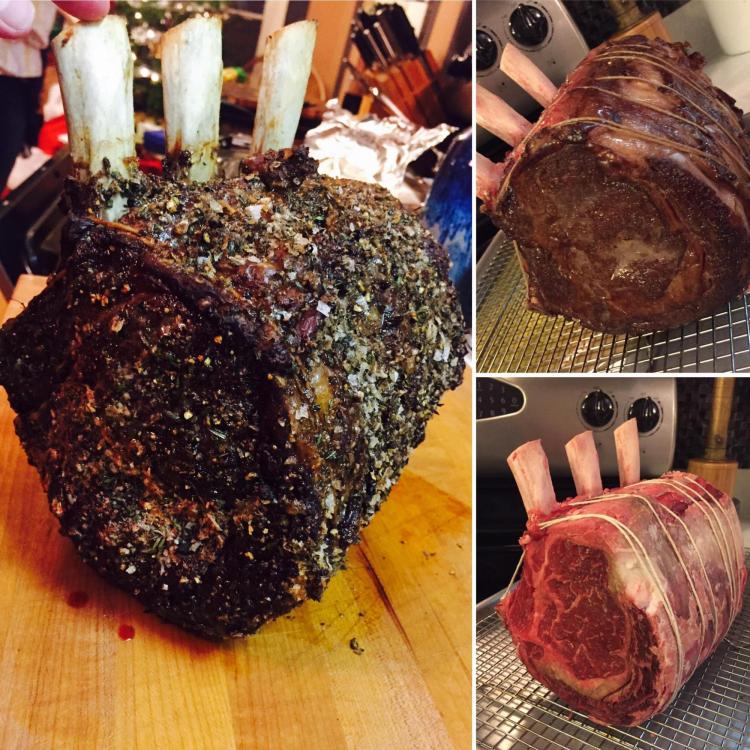-
Posts
1,807 -
Joined
-
Last visited
Content Type
Profiles
Forums
Store
Help Articles
Everything posted by btbyrd
-
Zingerman's is having their annual sale on balsamic vinegar.
-
Nice! That's the stovetop model I have. Works well... nice construction on the base.
-
"Sous vide" is an ambiguous term. Taking the term literally, "sous vide" refers to techniques that involve putting food in a vacuum machine. This need not even involve the application of heat; vacuum infusion and packaging for convenience/presentation would also qualify as sous vide. In this clip about "the art of sous vide," Chef Daniel Humm only uses SV for packaging avocado in a way that allows him to hold thin slices for service that would otherwise oxidize and discolor. The SV bag also works as a "sushi mat" to help roll the finished dish. Fancy equipment is required, but not for cooking (i.e., heating) purposes. However, most people use "sous vide" to refer to precise, low temperature cooking in a water bath. This doesn't require a vacuum machine and inherently involves the application of heat. Some foods, such as eggs, don't need to be sealed in order to be cooked with this method... and those foods that do need to be in a plastic bag are most often just fine in a Ziploc freezer bag. All you need for this type of SV cooking is an immersion circulator, and those have never been cheaper. All you need is a circulator, a pot, and some Ziplocs to get going with SV. And even that's not necessary. You can cook SV using Ziplocs, a cooler, hot water, and a thermometer. It's not nearly as precise, and it requires some babysitting... but you can still cook "sous vide" using low tech equipment.
-
It's always "ebooks, ebooks, ebooks!" with you people.
-
That sucks about the missing mounting screw. Glad you got that sorted! As for the TS8000 issue, it's been no secret that the TS8000 is the preferred torch head for the Searzall. The product description on both Amazon and the B&D website only list the TS8000 as the compatible torch head; it's not until you look through the manual or FAQ that the TS4000 is even mentioned. On the original Kickstarter page for the Searzall, they included a video demonstration comparing various torch heads and fuels so you can see (in real time) how much faster the TS8000 is compared to the TS4000. An interesting finding of that comparison test was that MAPP offered no real benefit on the TS8000, but sped things up considerably on the TS4000. At any rate, both Bernzomatic torches are sold as being compatible with both MAPP and propane, and the TS8000 is the #1 selling torch head on Amazon. MAPP isn't suggesed with the Searzall, but that's mostly because the MAPP canisters are smaller and the Searzall makes them tip over.
-
Scrub with kosher salt, wash thoroughly, reseason.
-
Thank goodness. I can't personally justify the expense (even though I'd really like one) but it would be a crying shame if these didn't get built. The design is so brilliant and there's nothing even close on the market. It's small, it's comparably cheap, and it can process large-ish batches using the pump. It's a hell of a design, and I hope they sell a boatload of them.
-
If "seasoning" means adding a durable, non-stick layer of polymerized oil and carbon to cast iron or carbon steel, it cannot be done at low temperatures.
-
The No. 27 is bigger than I thought. I just put an epic pre-sear on a 3-bone rib roast and it performed flawlessly. So nonstick there was basically zero cleanup. Baller. Before: After:
-
It doesn't remove it (if you're talking about the black layer of pre-seasoning) but it's not really supposed to. I gave the pans a quick wash in hot soapy water, then did the peels/salt/oil scrub to soak up whatever is allegedly on there. I don't know how necessary the step is, but it's recommended by ATK/CI as well as Matfer, so I figured it couldn't hurt.
-
You don't really need to season the handle. Whatever the black pre-seasoning is is robust enough to prevent rusting.... Not that you'd want to leave it sitting wet or anything, but it's effectively preseasoned for rust-prevention purposes. If you're going to season it in the oven for whatever reason, there's no reason not to go ahead and do the handle too.
-
I have the full set of Darto pans and like them a lot. I also have a larger Matfer coming as a Christmas present (because sometimes you need 12.75" for searing extra big things like roasts). I like the Dartos quite a bit. Like many, I learned about them from ChefSteps where they were used in a pan sauce video a while ago. There are a bunch of threads on these pans over on the ChefSteps forums, including a number of recent ones from people like Rotuts who picked up pans with the free shipping offer. My favorite aspect is the single-piece construction that eliminates rivets. I HATE cleaning around rivets... they never seem to get completely clean. I'm glad the Matfer has sanded/finished rivets so that it will be easier to clean. As for seasoning, I always do it on the stovetop by burning off a very thin layer of oil and wiping down as the oil starts smoking. I follow the ATK/CI method of initial seasoning for new carbon steel pans of cooking potato peels with a lot of oil and copious amounts of kosher salt. After that, it's the stovetop oil method. I find that doing it in the oven can leave a spotty finish, even if I wipe the layer of oil very, very thin. Others apparently have luck with that, but I don't. The Darto pans come semi-pre-seasoned with that black layer of finish that makes them resemble cast iron. They still need to be properly seasoned, but the initial base layer gives the pans an attractive and uniform "black all over" look that I like. I bought my first two pans without the free shipping, and the price of getting them to me was as much as one of the pans. The free shipping offer is worth taking advantage of if you're looking for some carbon steel. The pans are quite heavy, and the handles quite broad (which might be an issue if you have small hands). I have smallish hands, but find them a pleasure to grab with a side towel. The small pan is really quite small, but it can be useful for cooking smaller items and toasting spices if you have a bunch of other big stuff on the stovetop. The handle can heat up quickly if you use it on higher heat, but that's to be expected since it's rather short. The 15cm size is a "maybe" for me, but the rest of them are in constant rotation. The 20cm pan is just the right size for frying two eggs and having them come out in a perfect connected circle. The 23 and 27 immediately became good friends. They sear almost as well as cast iron and have good nonstick performance with very little fat. I reach for them much more often than my All Clads for most cooking tasks, though I wouldn't want to be without quality stainless.
-
You can get the Fatworks stuff online; Amazon sells it, but the prices are insane... currently $25 for a 14oz jar. My local Whole Foods sells tallow from the company Epic (that makes jerky, pemmican, and other paleo-ish meat products) for much more reasonable prices (though they're still quite expensive). I'm currently swimming in beef fat after a round of stock making (including the meat and fat I removed from the roast above), but it's from commodity beef so it doesn't have an especially healthy fatty acid profile. I'm saving it anyway... just going to double (or triple) up on fish oil on the days I use it. Tallow-fried potatoes are a magical thing...
-
My best friend was looking extra hopeful as I Frenched up my rib roast. I'm doing the ChefSteps recipe... pre-sear, SV @ 136F, blast in the oven with an herb crust.
-
Making a recipe for chili con carne that I've had floating in my head for a while. Did some short ribs at 130F for 72 hours, chilled them down, cut them into cubes, and froze them solid. I'm going to deep fry them from frozen and move them to a 130F bath with the chili base to let the flavors mingle. There will also be ground and braised short rib in the final version... I'm thinking these little cubes of medium rare short rib will add a special steaky meatiness to the dish. Froze them on parchment... Then sealed them up until it's time to fry. Planning on holding them in the sauce (post-fry) for an hour or so. Worth a shot, right?
-
If you're feeling extra-baller, you can finish it in a turkey fryer.
-
Yep. And presear the roast (if you can).
-
If you don't care about the crust, go for it. But if you put seared meat in a bag and hold it in a bath for any length of time, it's going to come out with a soggy bottom. If you need to need to speed up the pickup on SV short ribs, deep fry them. You can go from bath to plate in under 2 minutes. And that's including the time it takes to pat them dry.
-
Really sorry to hear about the bad luck you've been having with this. To avoid growth of spoilage bacteria during extended cooks, it's recommended to either pre-sear or do a quick initial blanch in boiling water to kill any surface bacteria. I almost always presear. I almost never blanch. Never had a problem.
-
This is my take as well. Is there anything round is actually good for? I know it's cheap, but that's about the only thing going for it. Unlike other inexpensive cuts, there's nothing you get from round you could get better elsewhere (if you're willing to pay) more. Is it ever delicious? Or is it only ever "just okay" -- the sort of thing to pile high on a sandwich before drowning it in horseradish sauce?
-
Exactly. They're just different. It's like comparing quality canned tuna to still-purple-inside seared yellowtail. "Which is better?" Wrong question. Anyway, here's a guide from ChefSteps on SV short rib time and temps. You will get similar results with cheek and shank.
-
And produce a radically different outcome. You can't make medium rare short ribs in a pressure cooker.




